Objective 1. Use SUM, AVERAGE, MIN, and MAX Functions
A function is a predefined formulaa formula that Excel has already built for youthat performs calculations by using specific values in a particular order or structure.
Activity 3.1. Using the SUM and AVERAGE Functions
Professor Danielson's lecture demonstrates the importance of looking at a variety of statistics to understand information. In this activity, you will use the SUM and AVERAGE functions to compare the average rainfall in two cities, measured in inches of rainfall per month.
|
1. |
Start Excel and Close |
||||||||||||||||||||||||||
|
2. |
In cell A1, type Average Rainfall Amounts in Buffalo and Seattle and in cell A2, type Measured in Inches of Rainfall per Month |
||||||||||||||||||||||||||
|
3. |
In cell A4 type Month In cell A5, type Jan and drag the fill handle down through cell A16 to have AutoFill complete the months of the year. Then, in the range B4:C16, enter the remaining column titles and data as shown below. Compare your screen with Figure 3.2. Figure 3.2. (This item is displayed on page 789 in the print version) 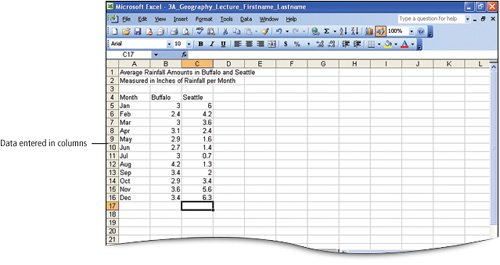
|
||||||||||||||||||||||||||
|
|
|||||||||||||||||||||||||||
|
4. |
In cell A17, type Sum and in cell A18, type Average Click cell B17, click AutoSum Figure 3.3. 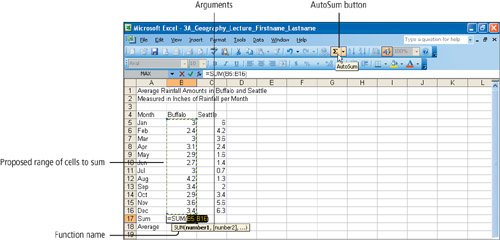
The SUM function that you have used is a predefined formula that adds all the numbers in a selected range of cells. Recall that because the SUM function is so frequently used, it has a button on the Standard toolbar. When you click the button, the SUM function is placed in the cell and the range of cells that Excel proposes to sum displays in parentheses. The values in parentheses are the argumentsthe values that an Excel function uses to perform calculations or operations. |
||||||||||||||||||||||||||
|
|
|||||||||||||||||||||||||||
|
5. |
Press |
||||||||||||||||||||||||||
|
6. |
Click cell B18, and then on the Formula Bar, click the Insert Function button |
||||||||||||||||||||||||||
|
7. |
Click the Or select a category arrow, and then click Statistical. Under Select a function, click AVERAGE. Compare your screen with Figure 3.4. Figure 3.4. 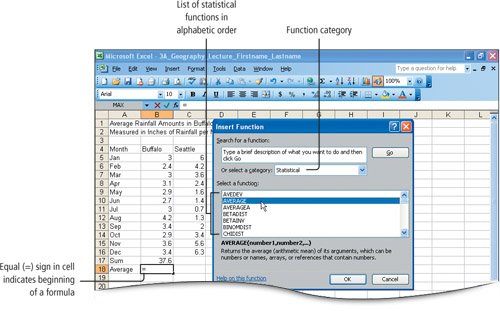
|
||||||||||||||||||||||||||
|
8. |
In the displayed dialog box, click OK to display the Function Arguments dialog box. |
||||||||||||||||||||||||||
|
9. |
In the Function Arguments dialog box, click in the Number1 box to display the insertion point, and then edit as necessary to display B5:B16 Alternatively, click the Number1 Collapse Dialog Box button, select the range B5:B16, and then click the Expand Dialog Box button. Compare your screen with Figure 3.5. Figure 3.5. 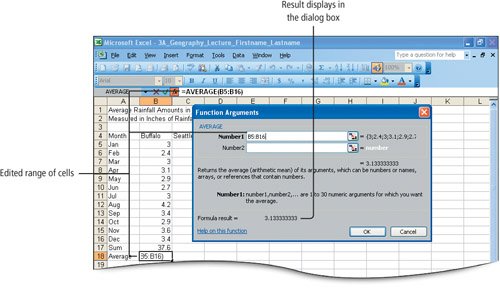
|
||||||||||||||||||||||||||
|
10. |
In the Function Arguments dialog box, click OK. |
||||||||||||||||||||||||||
|
11. |
Select the range B17:B18, and then drag the fill handle in the lower right corner of the selected range to the right to fill C17:C18. Notice that the sum of rainfall and the average rainfall per month for both cities is almost the same. |
||||||||||||||||||||||||||
|
12. |
Save |
Activity 3.2. Using the MIN and MAX Functions
The MIN function determines the smallest value in a selected range of values. The MAX function determines the largest value in a selected range of values.
Using Excel, Professor Danielson will demonstrate that the annual rainfall sum and average statistics are almost the same for the two cities in his examplebut these two statistics do not indicate how varied the rainfall patterns are during a typical year.
|
|
|
|
1. |
In cell A19, type Minimum and in cell A20, type Maximum |
|
2. |
Click cell B19. On the Formula Bar, click the Insert Function button |
|
3. |
In the displayed dialog box, click OK to display the Function Arguments dialog box; notice the proposed range indicated in the Number1 box. |
|
4. |
If necessary, move the Function Arguments dialog box so that you can view column Bpoint to the dialog box's blue title bar and drag it to the right of the screen. Then, select the range B5:B16. Alternatively, type the range in the Number1 box or click the Collapse Dialog Box button, select the range, and then click the Expand Dialog Box button. Compare your screen with Figure 3.6. Figure 3.6. 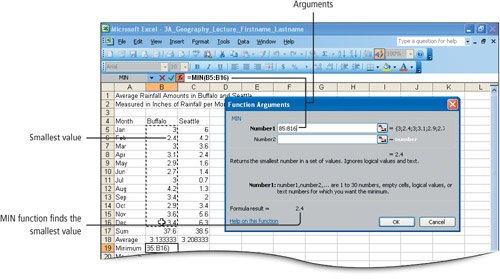
|
|
5. |
In the displayed dialog box, click OK. |
|
6. |
With cell B19 selected, drag the fill handle to the right to cell C19. |
|
|
|
|
7. |
Use the skills you just practiced to place the MAX function in cell B20 to find the maximum value in the range B5:B16 and then fill it into cell C20. Compare your screen with Figure 3.7. Figure 3.7. 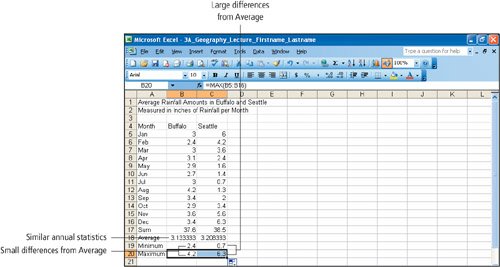
The maximum rainfall for Buffalo4.2is clearly lower than the maximum rainfall for Seattle6.3. The minimum and maximum monthly rainfalls for Buffalo are not very different from the average for Buffalo, but the minimum and maximum vary much more from the average for Seattle. Professor Danielson will use this example to show the importance of using more statistical functions than just SUM and AVERAGE. More Knowledge: The MEDIAN Statistical Function The MEDIAN statistical function is commonly used to describe a group of datayou have likely seen it used to describe the price of houses in a particular geographical area. The MEDIAN function finds the middle value that has as many values above it in the group as are below it. It differs from AVERAGE in that the result is not affected as much by a single value that is greatly different from the others. |
|
8. |
Save |
Activity 3.3. Moving Data and Adding Borders
If you need to move the data, you can select and move a range of cells containing data after the formulas and functions are in place. Excel will adjust the cell references in the formulas and functions relative to their new locations. Use borders to emphasize a range of cellsbordered data draws the reader's eye to a specific portion of a worksheet.
|
1. |
Select the range A4:C20. Point to the right edge of the selected range to display the Figure 3.8. 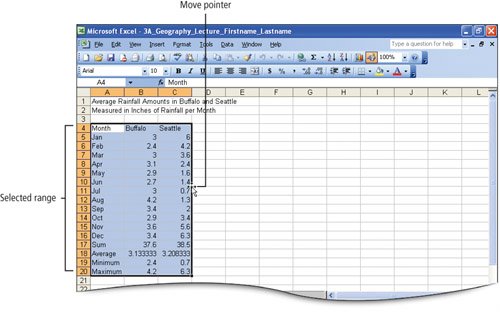
|
|
2. |
Drag the selected range to the right until the pointer is in column E and then release the mouse button. Click cell D17, and then look at the Formula Bar; notice that the arguments of the SUM function now refer to column D, as shown in Figure 3.9. Figure 3.9. 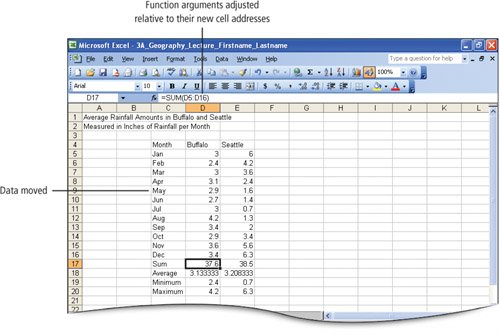
|
|
3. |
Select the range C17:E20, and then drag the range down one row to place the Maximum row on row 21. |
|
4. |
Click cell D18. On the Formula Bar, notice that the arguments of the SUM function still refers to the range D5:D16 even though the formula has been moved down one row. |
|
5. |
Select the range A1:G1, and then click the Merge and Center button |
|
6. |
Select the range D5:E16, hold down |
|
7. |
From the Format menu, display the Format Cells dialog box, click the Number tab, and then under Category, click Number. Click the Decimal places spin box down arrow to change the number of decimal places to 1, and then click OK. |
|
8. |
Select the nonadjacent ranges C4:E4 and C5:C16, apply Bold |
|
|
|
|
9. |
Select the range C18:E21. On the Formatting toolbar, click the Borders button arrow Figure 3.10. 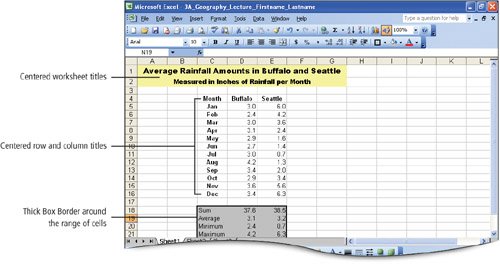
|
|
10. |
Rename Sheet1 as Rainfall Select Sheet2 and Sheet3 and delete them. Save |
|
[Page 796 (continued)] Objective 2 Use a Chart to Make Comparisons |
Windows XP
- Chapter One. Getting Started with Windows XP
- Project 1A. Windows XP
- Objective 1. Get Started with Windows XP
- Objective 2. Resize, Move, and Scroll Windows
- Objective 3. Maximize, Restore, Minimize, and Close a Window
- Objective 4. Create a New Folder
- Objective 5. Copy, Move, Rename, and Delete Files
- Objective 6. Find Files and Folders
- Objective 7. Compress Files
- Summary
- Key Terms
- Concepts Assessments
Outlook 2003
- Chapter One. Getting Started with Outlook 2003
- Getting Started with Microsoft Office Outlook 2003
- Project 1A. Exploring Outlook 2003
- Objective 1. Start and Navigate Outlook
- Objective 2. Read and Respond to E-mail
- Objective 3. Store Contact and Task Information
- Objective 4. Work with the Calendar
- Objective 5. Delete Outlook Information and Close Outlook
- Summary
- Key Terms
- Concepts Assessments
- Skill Assessments
- Performance Assessments
- Mastery Assessments
- Problem Solving
- GO! with Help
Internet Explorer
- Chapter One. Getting Started with Internet Explorer
- Getting Started with Internet Explorer 6.0
- Project 1A. College and Career Information
- Objective 1. Start Internet Explorer and Identify Screen Elements
- Objective 2. Navigate the Internet
- Objective 3. Create and Manage Favorites
- Objective 4. Search the Internet
- Objective 5. Save and Print Web Pages
- Summary
- Key Terms
- Concepts Assessments
- Skill Assessments
- Performance Assessments
- Mastery Assessments
- Problem Solving
Computer Concepts
- Chapter One. Basic Computer Concepts
- Objective 1. Define Computer and Identify the Four Basic Computing Functions
- Objective 2. Identify the Different Types of Computers
- Objective 3. Describe Hardware Devices and Their Uses
- Objective 4. Identify Types of Software and Their Uses
- Objective 5. Describe Networks and Define Network Terms
- Objective 6. Identify Safe Computing Practices
- Summary
- In this Chapter You Learned How to
- Key Terms
- Concepts Assessments
Word 2003
Chapter One. Creating Documents with Microsoft Word 2003
- Chapter One. Creating Documents with Microsoft Word 2003
- Getting Started with Microsoft Office Word 2003
- Project 1A. Thank You Letter
- Objective 1. Create and Save a New Document
- Objective 2. Edit Text
- Objective 3. Select, Delete, and Format Text
- Objective 4. Create Footers and Print Documents
- Project 1B. Party Themes
- Objective 5. Navigate the Word Window
- Objective 6. Add a Graphic to a Document
- Objective 7. Use the Spelling and Grammar Checker
- Objective 8. Preview and Print Documents, Close a Document, and Close Word
- Objective 9. Use the Microsoft Help System
- Summary
- Key Terms
- Concepts Assessments
- Skill Assessments
- Performance Assessments
- Mastery Assessments
- Problem Solving
- You and GO!
- Business Running Case
- GO! with Help
Chapter Two. Formatting and Organizing Text
- Formatting and Organizing Text
- Project 2A. Alaska Trip
- Objective 1. Change Document and Paragraph Layout
- Objective 2. Change and Reorganize Text
- Objective 3. Create and Modify Lists
- Project 2B. Research Paper
- Objective 4. Insert and Format Headers and Footers
- Objective 5. Insert Frequently Used Text
- Objective 6. Insert and Format References
- Summary
- Key Terms
- Concepts Assessments
- Skill Assessments
- Performance Assessments
- Mastery Assessments
- Problem Solving
- You and GO!
- Business Running Case
- GO! with Help
Chapter Three. Using Graphics and Tables
- Using Graphics and Tables
- Project 3A. Job Opportunities
- Objective 1. Insert and Modify Clip Art and Pictures
- Objective 2. Use the Drawing Toolbar
- Project 3B. Park Changes
- Objective 3. Set Tab Stops
- Objective 4. Create a Table
- Objective 5. Format a Table
- Objective 6. Create a Table from Existing Text
- Summary
- Key Terms
- Concepts Assessments
- Skill Assessments
- Performance Assessments
- Mastery Assessments
- Problem Solving
- You and GO!
- Business Running Case
- GO! with Help
Chapter Four. Using Special Document Formats, Columns, and Mail Merge
- Using Special Document Formats, Columns, and Mail Merge
- Project 4A. Garden Newsletter
- Objective 1. Create a Decorative Title
- Objective 2. Create Multicolumn Documents
- Objective 3. Add Special Paragraph Formatting
- Objective 4. Use Special Character Formats
- Project 4B. Water Matters
- Objective 5. Insert Hyperlinks
- Objective 6. Preview and Save a Document as a Web Page
- Project 4C. Recreation Ideas
- Objective 7. Locate Supporting Information
- Objective 8. Find Objects with the Select Browse Object Button
- Project 4D. Mailing Labels
- Objective 9. Create Labels Using the Mail Merge Wizard
- Summary
- Key Terms
- Concepts Assessments
- Skill Assessments
- Performance Assessments
- Mastery Assessments
- Problem Solving
- You and GO!
- Business Running Case
- GO! with Help
Excel 2003
Chapter One. Creating a Worksheet and Charting Data
- Creating a Worksheet and Charting Data
- Project 1A. Tableware
- Objective 1. Start Excel and Navigate a Workbook
- Objective 2. Select Parts of a Worksheet
- Objective 3. Enter and Edit Data in a Worksheet
- Objective 4. Construct a Formula and Use the Sum Function
- Objective 5. Format Data and Cells
- Objective 6. Chart Data
- Objective 7. Annotate a Chart
- Objective 8. Prepare a Worksheet for Printing
- Objective 9. Use the Excel Help System
- Project 1B. Gas Usage
- Objective 10. Open and Save an Existing Workbook
- Objective 11. Navigate and Rename Worksheets
- Objective 12. Enter Dates and Clear Formats
- Objective 13. Use a Summary Sheet
- Objective 14. Format Worksheets in a Workbook
- Summary
- Key Terms
- Concepts Assessments
- Skill Assessments
- Performance Assessments
- Mastery Assessments
- Problem Solving
- You and GO!
- Business Running Case
- GO! with Help
Chapter Two. Designing Effective Worksheets
- Designing Effective Worksheets
- Project 2A. Staff Schedule
- Objective 1. Use AutoFill to Fill a Pattern of Column and Row Titles
- Objective 2. Copy Text Using the Fill Handle
- Objective 3. Use AutoFormat
- Objective 4. View, Scroll, and Print Large Worksheets
- Project 2B. Inventory Value
- Objective 5. Design a Worksheet
- Objective 6. Copy Formulas
- Objective 7. Format Percents, Move Formulas, and Wrap Text
- Objective 8. Make Comparisons Using a Pie Chart
- Objective 9. Print a Chart on a Separate Worksheet
- Project 2C. Population Growth
- Objective 10. Design a Worksheet for What-If Analysis
- Objective 11. Perform What-If Analysis
- Objective 12. Compare Data with a Line Chart
- Summary
- Key Terms
- Concepts Assessments
- Skill Assessments
- Performance Assessments
- Mastery Assessments
- Problem Solving
- You and GO!
- Business Running Case
- GO! with Help
Chapter Three. Using Functions and Data Tables
- Using Functions and Data Tables
- Project 3A. Geography Lecture
- Objective 1. Use SUM, AVERAGE, MIN, and MAX Functions
- Objective 2. Use a Chart to Make Comparisons
- Project 3B. Lab Supervisors
- Objective 3. Use COUNTIF and IF Functions, and Apply Conditional Formatting
- Objective 4. Use a Date Function
- Project 3C. Loan Payment
- Objective 5. Use Financial Functions
- Objective 6. Use Goal Seek
- Objective 7. Create a Data Table
- Summary
- Key Terms
- Concepts Assessments
- Skill Assessments
- Performance Assessments
- Mastery Assessments
- Problem Solving
- You and GO!
- Business Running Case
- GO! with Help
Access 2003
Chapter One. Getting Started with Access Databases and Tables
- Getting Started with Access Databases and Tables
- Project 1A. Academic Departments
- Objective 1. Rename a Database
- Objective 2. Start Access, Open an Existing Database, and View Database Objects
- Project 1B. Fundraising
- Objective 3. Create a New Database
- Objective 4. Create a New Table
- Objective 5. Add Records to a Table
- Objective 6. Modify the Table Design
- Objective 7. Create Table Relationships
- Objective 8. Find and Edit Records in a Table
- Objective 9. Print a Table
- Objective 10. Close and Save a Database
- Objective 11. Use the Access Help System
- Summary
- Key Terms
- Concepts Assessments
- Skill Assessments
- Performance Assessments
- Mastery Assessments
- Problem Solving Assessments
- Problem Solving
- You and GO!
- Business Running Case
- GO! with Help
Chapter Two. Sort, Filter, and Query a Database
- Sort, Filter, and Query a Database
- Project 2A. Club Fundraiser
- Objective 1. Sort Records
- Objective 2. Filter Records
- Objective 3. Create a Select Query
- Objective 4. Open and Edit an Existing Query
- Objective 5. Sort Data in a Query
- Objective 6. Specify Text Criteria in a Query
- Objective 7. Print a Query
- Objective 8. Specify Numeric Criteria in a Query
- Objective 9. Use Compound Criteria
- Objective 10. Create a Query Based on More Than One Table
- Objective 11. Use Wildcards in a Query
- Objective 12. Use Calculated Fields in a Query
- Objective 13. Group Data and Calculate Statistics in a Query
- Summary
- Key Terms
- Concepts Assessments
- Skill Assessments
- Performance Assessments
- Mastery Assessments
- Problem Solving
- You and GO!
- Business Running Case
- GO! with Access Help
Chapter Three. Forms and Reports
- Forms and Reports
- Project 3A. Fundraiser
- Objective 1. Create an AutoForm
- Objective 2. Use a Form to Add and Delete Records
- Objective 3. Create a Form Using the Form Wizard
- Objective 4. Modify a Form
- Objective 5. Create an AutoReport
- Objective 6. Create a Report Using the Report Wizard
- Objective 7. Modify the Design of a Report
- Objective 8. Print a Report and Keep Data Together
- Summary
- Key Terms
- Concepts Assessments
- Skill Assessments
- Performance Assessments
- Mastery Assessments
- Problem Solving
- You and GO!
- Business Running Case
- GO! with Help
Powerpoint 2003
Chapter One. Getting Started with PowerPoint 2003
- Getting Started with PowerPoint 2003
- Project 1A. Expansion
- Objective 1. Start and Exit PowerPoint
- Objective 2. Edit a Presentation Using the Outline/Slides Pane
- Objective 3. Format and Edit a Presentation Using the Slide Pane
- Objective 4. View and Edit a Presentation in Slide Sorter View
- Objective 5. View a Slide Show
- Objective 6. Create Headers and Footers
- Objective 7. Print a Presentation
- Objective 8. Use PowerPoint Help
- Summary
- Key Terms
- Concepts Assessments
- Skill Assessments
- Performance Assessments
- Mastery Assessments
- Problem Solving
- You and GO!
- Business Running Case
- GO! with Help
Chapter Two. Creating a Presentation
- Creating a Presentation
- Project 2A. Teenagers
- Objective 1. Create a Presentation
- Objective 2. Modify Slides
- Project 2B. History
- Objective 3. Create a Presentation Using a Design Template
- Objective 4. Import Text from Word
- Objective 5. Move and Copy Text
- Summary
- Key Terms
- Concepts Assessments
- Skill Assessments
- Performance Assessments
- Mastery Assessments
- Problem Solving
- You and GO!
- Business Running Case
- GO! with Help
Chapter Three. Formatting a Presentation
- Project 3A. Emergency
- Objective 1. Format Slide Text
- Objective 2. Modify Placeholders
- Objective 3. Modify Slide Master Elements
- Objective 4. Insert Clip Art
- Project 3B. Volunteers
- Objective 5. Apply Bullets and Numbering
- Objective 6. Customize a Color Scheme
- Objective 7. Modify the Slide Background
- Objective 8. Apply an Animation Scheme
- Summary
- Key Terms
- Concepts Assessments
- Skill Assessments
- Performance Assessments
- Mastery Assessments
- Problem Solving
- You and GO!
- Business Running Case
- GO! with Help
Integrated Projects
Chapter One. Using Access Data with Other Office Applications
- Chapter One. Using Access Data with Other Office Applications
- Introduction
- Project 1A. Meeting Slides
- Objective 1. Export Access Data to Excel
- Objective 2. Create a Formula in Excel
- Objective 3. Create a Chart in Excel
- Objective 4. Copy Access Data into a Word Document
- Objective 5. Copy Excel Data into a Word Document
- Objective 6. Insert an Excel Chart into a PowerPoint Presentation
Chapter Two. Using Tables in Word and Excel
- Chapter Two. Using Tables in Word and Excel
- Introduction
- Project 2A. Meeting Notes
- Objective 1. Plan a Table in Word
- Objective 2. Enter Data and Format a Table in Word
- Objective 3. Create a Table in Word from Excel Data
- Objective 4. Create Excel Worksheet Data from a Word Table
Chapter Three. Using Excel as a Data Source in a Mail Merge
- Chapter Three. Using Excel as a Data Source in a Mail Merge
- Introduction
- Project 3A. Mailing Labels
- Objective 1. Prepare a Mail Merge Document as Mailing Labels
- Objective 2. Choose an Excel Worksheet as a Data Source
- Objective 3. Produce and Save Merged Mailing Labels
- Objective 4. Open a Saved Main Document for Mail Merge
Chapter Four. Linking Data in Office Documents
- Chapter Four. Linking Data in Office Documents
- Introduction
- Project 4A. Weekly Sales
- Objective 1. Insert and Link in Word an Excel Object
- Objective 2. Format an Object in Word
- Objective 3. Open a Word Document That Includes a Linked Object, and Update Links
Chapter Five. Creating Presentation Content from Office Documents
EAN: 2147483647
Pages: 448
 the Getting Started task pane. From the File menu, display the Save As dialog box, click the Save in arrow, and then navigate to the location where you are storing your projects. Click the Create New Folder button
the Getting Started task pane. From the File menu, display the Save As dialog box, click the Save in arrow, and then navigate to the location where you are storing your projects. Click the Create New Folder button  and name the folder Excel Chapter 3 and then press
and name the folder Excel Chapter 3 and then press  to make your new folder the active folder. In the File name box, type 3A_Geography_Lecture_Firstname_Lastname and then click Save or press
to make your new folder the active folder. In the File name box, type 3A_Geography_Lecture_Firstname_Lastname and then click Save or press  , and then compare your screen with Figure 3.3.
, and then compare your screen with Figure 3.3. . Alternatively, from the Insert menu, click Function.
. Alternatively, from the Insert menu, click Function. your workbook.
your workbook. pointer, and then compare your screen with Figure 3.8.
pointer, and then compare your screen with Figure 3.8. . Change the font to Arial Black, change the font size to 12, and then change the Fill Color to Light Yellow. Select the range A2:G2, Merge and Center
. Change the font to Arial Black, change the font size to 12, and then change the Fill Color to Light Yellow. Select the range A2:G2, Merge and Center  , and then select the range D18:E21. Alternatively, in the Name Box, type d5:e16,d18:e21 and then press
, and then select the range D18:E21. Alternatively, in the Name Box, type d5:e16,d18:e21 and then press  emphasis and Center
emphasis and Center  the values in their cells.
the values in their cells. , and then from the displayed palette, in the third row click the fourth borderThick Box Border. With the range still selected, change the Fill Color to Gray 25%. Click outside the selected area to deselect, and then compare your screen with Figure 3.10.
, and then from the displayed palette, in the third row click the fourth borderThick Box Border. With the range still selected, change the Fill Color to Gray 25%. Click outside the selected area to deselect, and then compare your screen with Figure 3.10.